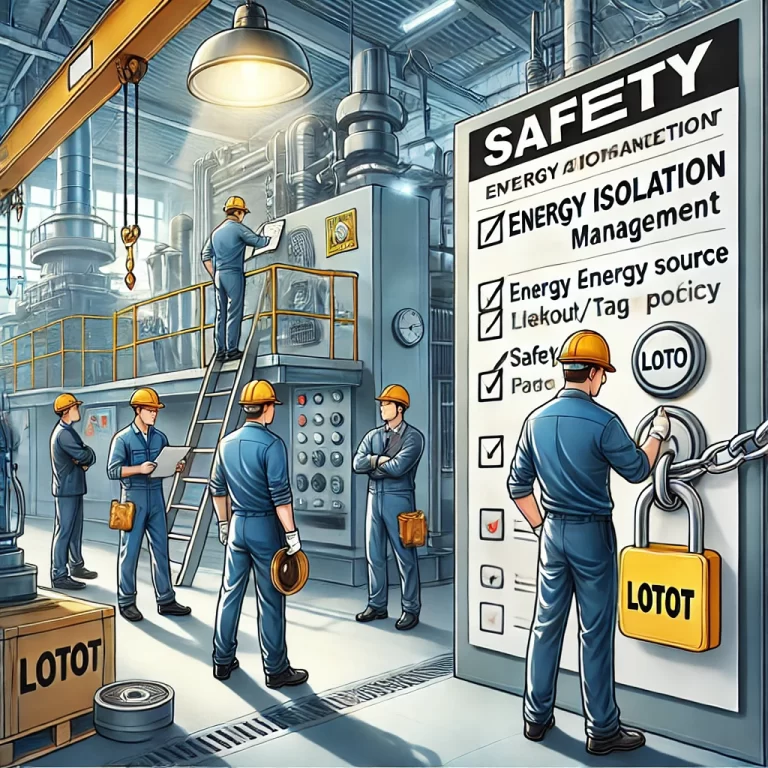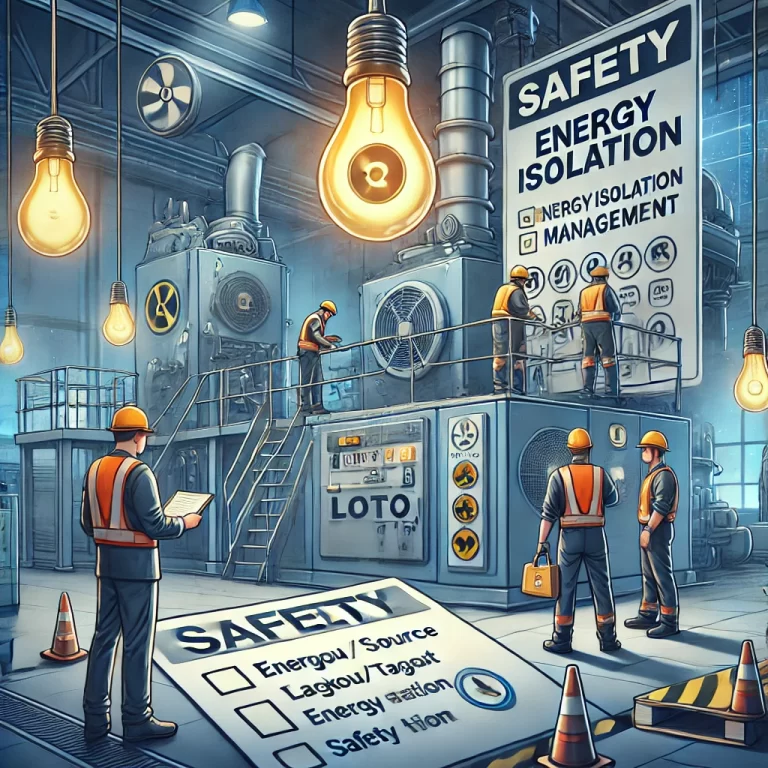Chapter 1: General Provisions
1. Purpose
This policy aims to ensure the safety of personnel and equipment by preventing accidental exposure to hazardous energy during maintenance, servicing, or other activities. Implementing strict energy isolation procedures reduces the risk of injuries, fatalities, and property damage.
2. Scope
This policy applies to all personnel, equipment, and systems that involve hazardous energy sources, such as electrical, mechanical, hydraulic, pneumatic, thermal, or other stored energies within the organization’s operations.
Chapter 2: Roles and Responsibilities
1. Management Responsibilities
- Develop and approve the energy isolation management policy and associated procedures.
- Ensure adequate resources, including tools, locks, and tags, are available for implementation.
- Conduct regular reviews of policy effectiveness and compliance.
2. Departmental Supervisors
- Oversee the proper execution of energy isolation procedures within their departments.
- Ensure that all personnel under their supervision are trained and aware of isolation requirements.
3. Authorized Personnel
- Follow energy isolation procedures accurately.
- Verify energy sources are fully isolated and report any irregularities in the system.
4. Safety Management Team
- Conduct periodic audits of isolation measures.
- Organize training programs and emergency response drills related to energy isolation.

Chapter 3: Policy Requirements
1. Fundamental Requirements for Energy Isolation
- Energy isolation must be implemented for maintenance, servicing, cleaning, or any activity that might expose personnel to hazardous energy.
- Unauthorized personnel are prohibited from tampering with isolation devices or equipment.
2. Step-by-Step Isolation Procedures
- Step 1: Identify Hazardous Energy Sources
Locate and document all energy sources connected to the equipment or system. - Step 2: Shut Down Equipment
Power off the equipment and bring it to a complete stop. - Step 3: Isolate Energy Sources
Use approved lockout/tagout (LOTO) devices to physically isolate energy sources. Ensure all energy valves, switches, or circuits are in the off or neutral position. - Step 4: Release Residual Energy
Safely release any residual or stored energy, such as hydraulic pressure, compressed air, or spring tension, to eliminate potential hazards. - Step 5: Verify Isolation
Conduct tests (e.g., voltage testing or mechanical motion checks) to confirm all energy sources are properly isolated.
3. Lockout/Tagout Devices
- Each lock and tag must be uniquely identifiable and assigned to authorized personnel.
- Tags must display clear information, including the name of the person applying the device, the date of application, and the purpose of the lockout.
4. Removal of Isolation
- Ensure all work is completed, tools are removed, and the area is inspected for safety.
- Notify affected personnel before removing locks or tags.
- Follow a reverse sequence of the isolation procedure to restore equipment to operational status.
Chapter 4: Training and Documentation
1. Training Requirements
- All employees must receive initial training on energy isolation safety.
- Authorized personnel must undergo specific lockout/tagout training, focusing on hands-on practice.
- Refresher training should be conducted annually or when procedures or equipment change.
2. Documentation and Record-Keeping
- Each isolation procedure must be documented, including:
- Date and time of isolation.
- Identification of isolated energy sources.
- Names of authorized personnel performing and verifying the isolation.
- Time and date of restoration.
- Records must be maintained for a minimum of two years for auditing and compliance purposes.

Chapter 5: Audits and Compliance
1. Inspections
- The safety management team will conduct quarterly inspections to verify compliance with the energy isolation policy.
- Reports will include identified non-compliance issues, corrective actions taken, and follow-up assessments.
2. Rewards and Penalties
- Departments and individuals who strictly adhere to energy isolation procedures and achieve safety milestones will receive recognition and rewards.
- Non-compliance with energy isolation procedures will result in disciplinary actions, including retraining or penalties, depending on the severity of the violation.
Chapter 6: Supplementary Provisions
1. Effective Date
This policy is effective immediately upon issuance.
2. Interpretation
The Safety Management Team is responsible for interpreting and updating this policy as necessary to reflect changes in regulations, technology, or operational needs.
Appendices
- Appendix A: Types of Hazardous Energy Sources
- Appendix B: Example Lockout/Tagout Device Specifications
- Appendix C: Emergency Response Procedure for Energy Isolation Failures
This detailed policy serves as a comprehensive guide to safeguard employees and facilities by enforcing stringent energy isolation measures. It ensures that all parties involved are equipped, trained, and accountable for maintaining a safe working environment.
